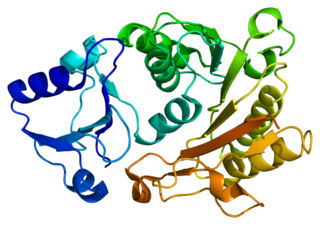
BMP and activin membrane-bound inhibitor homolog , also known as BAMBI, is a protein which in humans is encoded by the BAMBI gene.

Zinc finger transcription factor Trps1 is a protein that in humans is encoded by the TRPS1 gene.

Frizzled-9(Fz-9) is a protein that in humans is encoded by the FZD9 gene. Fz-9 has also been designated as CD349.

Claspin is a protein that in humans is encoded by the CLSPN gene.

Max-like protein X is a protein that in humans is encoded by the MLX gene.

H(+)/Cl(-) exchange transporter 4 is a protein that in humans is encoded by the CLCN4 gene.

Single-minded homolog 1, also known as class E basic helix-loop-helix protein 14 (bHLHe14), is a protein that in humans is encoded by the SIM1 gene.

Structural maintenance of chromosomes protein 4 (SMC-4) also known as chromosome-associated polypeptide C (CAP-C) or XCAP-C homolog is a protein that in humans is encoded by the SMC4 gene. SMC-4 is a core subunit of condensin I and II, large protein complexes involved in chromosome condensation.

Condensin complex subunit 1 also known as chromosome-associated protein D2 (CAP-D2) or non-SMC condensin I complex subunit D2 (NCAPD2) or XCAP-D2 homolog is a protein that in humans is encoded by the NCAPD2 gene. CAP-D2 is a subunit of condensin I, a large protein complex involved in chromosome condensation.

Carbohydrate-responsive element-binding protein (ChREBP) also known as MLX-interacting protein-like (MLXIPL) is a protein that in humans is encoded by the MLXIPL gene. The protein name derives from the protein's interaction with carbohydrate response element sequences of DNA.

Visual system homeobox 2 is a protein that in humans is encoded by the VSX2 gene.

Uncharacterized methyltransferase WBSCR22 is an enzyme that in humans is encoded by the WBSCR22 gene.

Anterior gradient protein 3 homolog is a protein that in humans is encoded by the AGR3 gene.

Putative methyltransferase NSUN5 is an enzyme that in humans is encoded by the NSUN5 gene.

Subunit P of phosphatidylinositol N-acetylglucosaminyltransferase is an enzyme that in humans is encoded by the PIGP gene.

Putative polypeptide N-acetylgalactosaminyltransferase-like protein 3 is an enzyme that in humans is encoded by the WBSCR17 gene.

Abhydrolase domain-containing protein 11 also known as Williams-Beuren syndrome chromosomal region 21 protein (WBSCR21) is an enzyme that in humans is encoded by the ABHD11 gene.

R-spondin-3 is a protein that in humans is encoded by the RSPO3 gene.

DnaJ homolog subfamily C member 30 (DNAJC30), also known as Williams Beuren syndrome chromosome region 18 protein (WBSCR18), is a protein that in humans is encoded by the DNAJC30 gene. This intronless gene encodes a member of the DNAJ molecular chaperone homology domain-containing protein family. This gene is deleted in Williams syndrome, a multisystem developmental disorder caused by the deletion of contiguous genes at 7q11.23.

Shroom family member 2 is a protein that in humans is encoded by the SHROOM2 gene.













